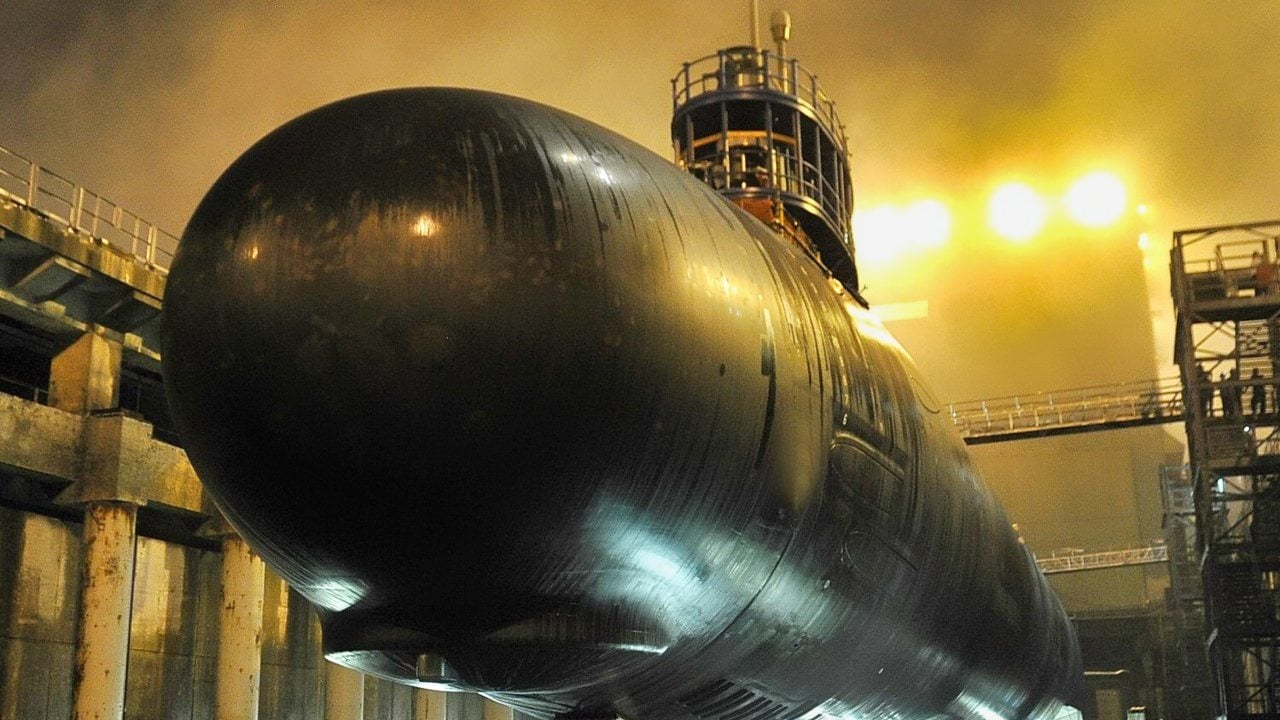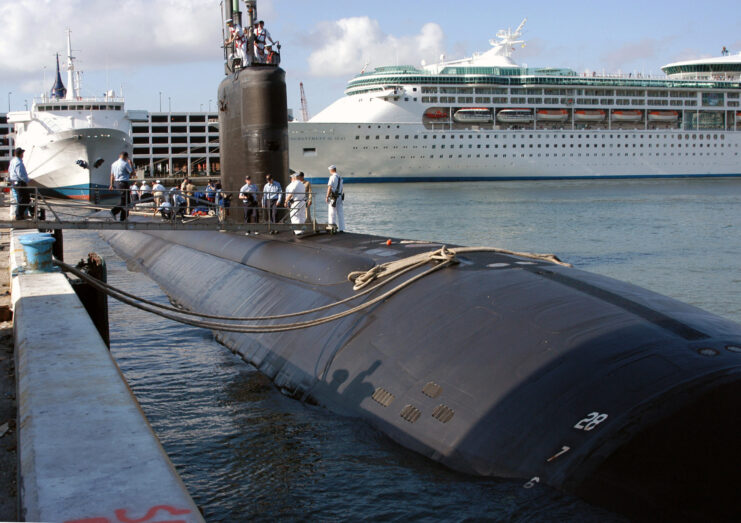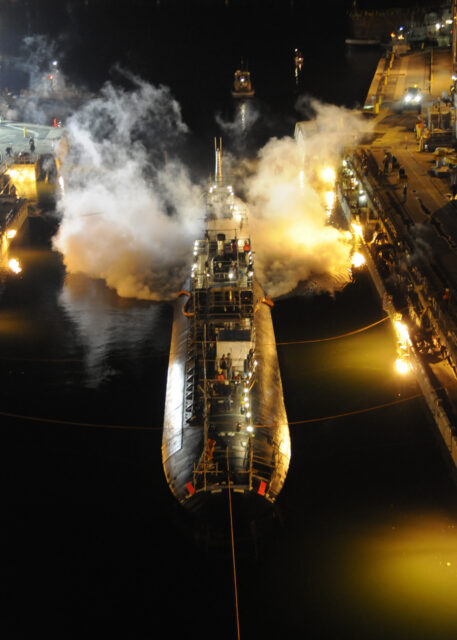How to Destroy a U.S. Navy Ship: Put it in a Shipyard and Light It Up
Summary
The USS Miami, a Los Angeles-class attack submarine, has a tragic story highlighting waste and security issues within the U.S. Navy. Built in 1986, the Miami caught fire in 2013 while docked for maintenance at the Portsmouth Naval Shipyard in Kittery, Maine. The blaze, started by civilian contractor Casey James Fury who was struggling with mental health issues, caused over $400 million in damage. Despite the submarine's potential for refurbishment or sale, the Navy opted to scrap it.
Investigations revealed that shipyard firefighters and Navy crews were unprepared for such a large-scale fire, having focused on smaller incidents in their drills. Complacency and assumptions about the proximity of firefighting assets led to organizational reluctance in preparing for worst-case scenarios. The incident raises concerns about base security and the vulnerability of critical assets, emphasizing the need for better mental health assessments, improved fire response preparedness, and strategic asset management within the U.S. Navy.
A lesson not learned
Apparently the Navy didn't learn its lesson, or this had all been forgotten by the Navy in San Diego only 7 years later. A Navy report concluded there were sweeping failures by commanders, crew members and others that fueled the July 2020 arson fire that destroyed the USS Bonhomme Richard, calling the massive five-day blaze in San Diego preventable and unacceptable.
While one sailor has been charged with setting the fire [later found not guilty], the more than 400-page report, lists three dozen officers and sailors whose failings either directly led to the ship’s loss or contributed to it. The findings detailed widespread lapses in training, coordination, communication, fire preparedness, equipment maintenance and overall command and control.
How to Destroy a U.S. Navy Nuclear Attack Submarine: Light It On Fire | The National Interest
Summary and Key Points: The USS Miami, a Los Angeles-class attack submarine, has a tragic story highlighting waste and security issues within the U.S. Navy.

-Built in 1986 for various missions, the Miami caught fire in 2013 while docked for maintenance.
-The blaze, started by a civilian contractor struggling with mental health issues, caused over $400 million in damage. Despite the submarine's potential for refurbishment or sale, the Navy opted to scrap it.
-This incident raises concerns about base security and the vulnerability of critical assets, emphasizing the need for better mental health assessments and strategic asset management.
The Tragic Tale of USS Miami: A Lesson in Navy Waste and Security
The Los Angeles-class attack submarine is the backbone of the U.S. Navy’s silent service and has been since the 1970s. There are many Los Angeles-class submarines with great legacies.
But one of these submarines – the fourth built in this class, the USS Miami – has a sad story. It is a story that must be better understood in this age of grayzone conflict – or of the “campaign between wars,” as the Israelis define it. It’s also yet another tale of waste by the U.S. Department of Defense.
Built in 1986 at Groton, Conn., by the General Dynamics Corporation, the USS Miami was a nuclear-powered attack submarine that was designed for a variety of missions, including intelligence gathering, insertion of special forces teams into enemy territory, and anti-submarine warfare.
She was equipped with four torpedo tubes and could carry up to 26 weapons, including Mark 48 torpedoes, the ubiquitous Tomahawk cruise missile, and Harpoon anti-ship missiles.
Powered by a single S6G reactor, which provided steam to two turbines driving a single shaft, the Miami had a length of 362 feet, a beam of 33 feet, and a draft of 31 feet. She displaced 6,927 tons when submerged and had a maximum speed of over 25 knots when cruising beneath the waves. The Miami carried a crew of 121 enlisted personnel and was commanded by 12 officers.
The Fire
Despite the advanced nature of this boat, she caught fire on May 23, 2013, while being overhauled at the Portsmouth Naval Shipyard in Kittery, Maine.
The fire started in a forward compartment on the sub and rapidly spread throughout the vessel. It took firefighters an astonishing 12 hours to extinguish the blaze.
The damage done to the submarine was estimated at over $400 million.
After an investigation, Navy authorities concluded that a civilian contractor from the shipyard where the Miami was docked for maintenance, Casey James Fury, started the fire. Apparently, he was struggling with severe anxiety and depression. According to Fury’s own admission after the fact, he set the blaze onboard the submarine in order to get out of work early.
Ultimately, Fury was convicted of arson, sentenced to 17 years in prison, and ordered to pay $400 million in restitution.

Despite the need for submarines and the fact that the boat could have been refurbished (or at least sold to an allied nation in need of the system, such as Japan, Taiwan, or Australia), the Navy opted instead to simply scrap the boat. This follows a pattern that has been repeated for years, even though the Navy does not have enough newer submarines to replace the Los Angeles-class subs.
So, one mentally disturbed contractor was able to obliterate a system that costs a little more than $1 billion to build and hundreds of millions of dollars to maintain over the course of its service to the country.
A Total Waste
But the really interesting and frightening part of the story was how one unarmed man could do that kind of damage to the Miami. Imagine if he were serving foreign interests.
Over the last several years, there has been a steady increase in attempts by foreign nationals to illegally enter Navy bases in the United States.
Who’s to say that China’s pernicious intelligence operations directed against US military targets within the United States doesn’t involve sabotaging US nuclear submarines while they are in port?
This could prove to be seriously threatening to U.S. forces from a strategic perspective, especially since the submarine force will be the most important element of the U.S. Navy’s response to a potential war with China.
Better security at our bases, a greater understanding of the mental health of sailors as well as contractors, and a sustainment of the aging Los Angeles-class submarine fleet – as well as the selling to allies’ navies of excess units about to be retired – are all ways forward.
About the Author
Brandon J. Weichert, a National Interest national security analyst, is a former Congressional staffer and geopolitical analyst who is a contributor at The Washington Times, the Asia Times, and The-Pipeline. He is the author of Winning Space: How America Remains a Superpower, Biohacked: China’s Race to Control Life, and The Shadow War: Iran’s Quest for Supremacy. His next book, A Disaster of Our Own Making: How the West Lost Ukraine, is due October 22 from Encounter Books. Weichert can be followed via Twitter @WeTheBrandon.
All images are Creative Commons.
The $700 Million Nuclear Submarine Fire Caused By a Worker Who Wanted to Go Home Early
The Devastating Fire That Caused $700 Million In Damages to the USS Miami (SSN-755) and Forced Her Decommissioning
The submarine USS Miami (SSN-755) was decommissioned as a result of a planned fire that caused significant damage. Although there appeared to be no malicious intent behind the incident, the vessel still suffered enough destruction that the US Navy made the decision to scrap her. The individual responsible is still serving his prison sentence.
USS Miami (SSN-755)

The USS Miami was a Los Angeles-class nuclear submarine built by the Electric Boat Division of General Dynamics Corporation. Work began on October 24, 1986, and she was launched just over two years later. She fell under the command of Cmdr. Thomas W. Mader upon her commissioning on June 30, 1990.
Most notable about Miami‘s service career was that she became the first submarine to participate in combat operations in two different theaters since the Second World War. She was active in both the 1998 bombing of Iraq (codenamed Operation Desert Fox) and the NATO bombing of Yugoslavia in the early-to-middle part of 1999 (codenamed Operation Allied Force). Her ability to fire cruise missiles led to her being nicknamed “Big Gun” during this time.
Though her homeport was in Groton, Connecticut, Miami arrived at the Portsmouth Naval Shipyard in Kittery, Maine on March 1, 2012. She was to remain there for a planned 20-month overhaul and upgrade.
A fire is set aboard the USS Miami (SSN-755)

On May 23, 2012, a fire broke out aboard the USS Miami that quickly spread and caused considerable damage. It was determined the blaze had been set by 25-year-old shipyard worker Casey James Fury, who’d been hired to perform painting and sandblasting work onboard the submarine. Apparently, Fury had set fire to a plastic bag full of rags, which he left on a bunk in a stateroom. It burned for 12 hours, and more than 100 firefighters were required to put out the blaze.
The fire caused damage to Miami‘s forward components, including her command and control center, living quarters and torpedo room. Thankfully, it didn’t spread toward the rear of the submarine, where the nuclear propulsion components were held. Seven (some sources say five) firefighters were injured while trying to squelch it.
Fury told authorities that he’d set the fire because he’d been suffering an anxiety attack and wanted to go home. About three weeks following the blaze, he tried to set another smaller fire on Miami, saying, again, that he’d wanted to go home and that his anxiety was to blame. He subsequently pleaded guilty to two counts of arson and was sentenced to 17 years in federal prison. He was also ordered to pay $400 million in restitution.
Decision to decommission the submarine
Initial estimates put the financial damage of the fire aboard the USS Miami at $450 million. It was determined there was little major damage, and the Navy decided to try and repair the submarine. The goal was to use spare parts from decommissioned vessels, so that work could be completed by the middle of 2015.
When repairs began, however, budget cuts were made and other issues arose, causing costs to balloon to $700 million. As such, the Navy decided, instead, to scrap Miami.
The USS Apache (ATF-67) and Navajo (AT-64) aided in towing Miami to the Puget Sound Naval Shipyard for dismantling, after which she was destined for a federal repository in Idaho. Upon her arrival at the shipyard, workers removed her equipment and systems, emptied her hydraulic fluids and oil, de-energized her electrical systems, and removed her main battery.
Casey James Fury claims he’s not guilty of setting the blaze
In 2015, Casey James Fury claimed he was innocent of the charges against him and hadn’t started the fires. He alleged he was forced to make a false confession, as he was being threatened with life in prison. “I don’t believe I’m responsible,” he told The Portsmouth Herald from the federal penitentiary in Fort Dix, New Jersey. “I don’t believe I did it. I don’t remember doing it.”
Fury claims that it wasn’t long after he’d begun working at the shipyard that he developed anxiety and depression, and began having panic attacks. He also told the publication that, at that time, he’d been suffering with addiction, often mixing alcohol with prescription medication. He believes these factors weren’t taken into consideration during his trial and wants a judge to take a second look at his sentence.
As a result of his inebriation, Fury said he couldn’t even remember making the confession. “I don’t think I remember going to work that day,” he said. Regardless of these revelations, he’s still serving out his sentence.
Navy Unprepared for Arson Fire on Nuclear Sub USS Miami: Report
Shipyard firefighters and Navy crews were unprepared for an arson fire that swept through a submarine and burned for hours on end, exhausting firefighters and crippling a $900 million nuclear submarine, according to hundreds of pages of documents obtained by The Associated Press. The personnel had participated in 54 fire drills over a three-year period but Navy investigators concluded that firefighters needed to spend more time preparing for a worst-case scenario event after the May 2012 fire aboard the USS Miami at the Portsmouth Naval Shipyard.
Investigators said shipyard workers squandered precious minutes after the fire was set by delaying a fire alarm and looking in the wrong place for the fire. "Complacency had set in, based on the infrequency of shipyard fires and relative success of fire prevention measures," they wrote. "Also, there was an assumption that the proximity to far more assets, especially federal firefighters, reduced the likelihood of a fire not being quickly contained. This organizational reluctance to prepare for a fire of this scale should serve as a wake-up call — large fires can and do happen in industrial environments." The Navy says it has learned lessons from the Miami fire. "We will continue to apply best response practices into shipyard fire emergency plans," Lt. Timothy Hawkins, a Navy spokesman, said from the Pentagon.

Comments
Post a Comment